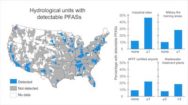
Reports of polluted drinking water contaminating whole communities have flooded in recently. As if we didn’t need another reason to unplug, various studies have uncovered the truth about our ‘drinking water’. It is diseased and ‘deadly toxic’.
In the US, more than six million people drink contaminated water, plagued with PFASs, which have been linked to cancer, hormone disruption, high cholesterol and obesity. This is according to a Harvard University study published in August which used data from more than 36,000 water samples collected from all over the nation by the U.S. Environmental Protection Agency (EPA) from 2013-2015. You can view their advice here.
Lead author of the study, Xindi Hu, says that: “For many years, chemicals with unknown toxicities, such as PFASs, were allowed to be used and released into the environment.” The toxins have been used over the last 60 years in many things from food wrappers to clothing, to cooking utensils. “We now have to face the severe consequences” Hu added.
The worst affected states are as follows: California, New Jersey, North Carolina, Alabama, Florida, Pennsylvania, Ohio, New York, Minnesota, Arizona, Massachusetts and Illinois.

Drinking water was tested in 33 states, the study set the limit as 70 parts of PFASs per trillion (ng/L). Concentrations ranged as high as 1,800 ng/L for PFOS (Newark, Delaware).
A separate national report released Tuesday (Sept. 20) found unsafe levels of chromium-6 or hexavalent chromium — known to cause cancer in animals and humans — in tap water across the country.
But the States are not alone, one of the world’s leading human rights group has focused on the consequences of contaminated water in indigenous communities throughout Ontario, Canada.
In a study that lasted almost a year, Human Rights Watch collected samples of water in Batchewana, Grassy Narrows, Shoal Lake 40, Neskantaga and Six Nations of Grand River. Whilst conducting their research, they found children suffering from skin disorders, mothers who spent hours a day disinfecting their babies’ bottles, due to the presence of E.coli and other toxins in the water. You can view the gallery they complied whilst carrying out the research here.
The ‘make it safe’ campaign has been set up as Canada’s obligation to end the water crisis. Ontario Regional Chief, Isadore Day called the lack of clean water in 2016 “discriminatory and unacceptable”.
The HRW wants to know why Indigenous and Northern Affairs Canada (INAC), failed to spend funds over five recent fiscal years and sent more than $1 billion in funds back to the Treasury Board as “surplus” when it could have been used to clean up the water, the report said.
The group has praised the new government of Prime Minister Justin Trudeau despite this, for promising $4.6bn earmarked for infrastructure funds in indigenous communities over the next five years.
That’s not all – more than 300,000 UK homes were affected by the cryptosporidium parasite found in water supplies last year when animal excrement was leaked into the Franklaw Water Treatment plant in Garstang. People were warned to not drink or use the tap water unless they have boiled it as the microscopic bug infected those with sickness and diarrhea. The company said it was making “good progress” in tackling the problem which it maintained posed a “very low” health risk but the precaution needed to stay in place.
Many are asking the question: why is this an issue in 2016 and in some of the most developed countries in the entire world? It is shocking that communities are being let down by the governments on something as basic as polluted water. If there ever was a time to start converting to your own drinking water, it is now.